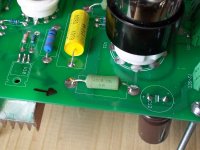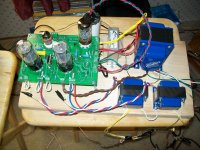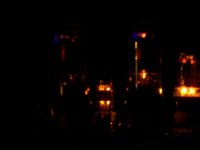So my Edkor package arrived today. I threw caution to wind and hooked up everything. I gave it a quick try, with no input, and I had no smoke or apparent problems. Next I hooked up some speakers and input source, sound came out, but it was very soft and heavily distorted. After about a minute I smelled something getting hot and then immediately pulled the plug. I checked around the board and determined that the bias resistors were starting to get hot. So I went though all the wiring again and could not see a posible problem. So I decided to go back to sqaure one, where I should have started to begin with. I pulled all the tubes and measured my voltages coming out of the transformer. I got the following values.
669 AC, 334 at the tap, on a transformer that's supposed to be 600 VCT
7.25 AC on the filament.
6.13 AC on the rectifier.
I check this with both a newer digital meter, and my 20+ year old RAT Shack analog VOM and got the same results. Since I'm somewhat new to tubes, I'm wondering are these values right, and I'm just measuring peak values instead of RMS, hence I did something wrong in my soldering, or did I posibly get a transformer rated for a lower input voltage. This is the transformer I was supposed too get. https://www.edcorusa.com/p/791/xpwr172_120-220
Any help or ideas are much welcomed.
669 AC, 334 at the tap, on a transformer that's supposed to be 600 VCT
7.25 AC on the filament.
6.13 AC on the rectifier.
I check this with both a newer digital meter, and my 20+ year old RAT Shack analog VOM and got the same results. Since I'm somewhat new to tubes, I'm wondering are these values right, and I'm just measuring peak values instead of RMS, hence I did something wrong in my soldering, or did I posibly get a transformer rated for a lower input voltage. This is the transformer I was supposed too get. https://www.edcorusa.com/p/791/xpwr172_120-220
Any help or ideas are much welcomed.
Laid in bed, and suddenly had brain flash. I wired the preamp wrong. So I got up a quickly tried it again. This time sound coming out fine, amp works. Bais resistors are still getting very hot though. Now wondering if Mouser really sent me 5 watt resistors. Going back to bed, will look at it in the morning.
669 AC, 334 at the tap, on a transformer that's supposed to be 600 VCT
Over voltage transformers are pretty common today. Your numbers were measured with no load, which will give high readings.
Bais resistors are still getting very hot though.
I am assuming that you are referring to the cathode resistors. If they are white ceramic, thats the right ones. They will get quite hot, too hot to leave your finger on for more than a few seconds.
Measure the voltage across each one and tell us what you get. What output tubes are you using.
Tube are 6n3c, voltage across resistor is 27.8 and 30 on the other. The resitors I got from Mouser were not the square ones. They look like normal resistors but they are wirewound and suposed to be rated for 5 watts. Should I replace them. I'd post pictures but they method of doing so without a link is alluding me at the moment. I have used the amp for a few hours this morning everything is working fine, sounds fantastic. They only thing that somewhat worries me is the heat of the resistors.
Thanks James,
Thanks James,
There will be slightly more voltage on C1 than C2. The voltage on C2 is your B+.
30 volts across 430 ohms is 69.7 mA. This gives 2.1 watts of heat in the resistor which will make it quite hot, but shouldn't fry a 5 watt resistor. Post the Mouser part number so we can check the specs. (look at max temp, it's probably pretty high like 175C or even 225C)
The tubes will see the B+ voltage minus the cathode voltage (minus the loss in the OPT). Neglecting the OPT loss and assuming your B+ is 378 volts the hottest tube is dissipating about 24 watts. ( 378 - 30 * .0697 = 24.26 W)
I have never used the 6n3c, so I don't know if this is OK. Look at the tubes in a dark room. The plate (outer metal element) should not have any orange glow on any surface. If it is glowing, you need to use a larger cathode resistor (470 or 510 ohms). If it's not, I think your amp is OK.
I used are 430 ohms, 5 watt, 5% tolerance.
30 volts across 430 ohms is 69.7 mA. This gives 2.1 watts of heat in the resistor which will make it quite hot, but shouldn't fry a 5 watt resistor. Post the Mouser part number so we can check the specs. (look at max temp, it's probably pretty high like 175C or even 225C)
The tubes will see the B+ voltage minus the cathode voltage (minus the loss in the OPT). Neglecting the OPT loss and assuming your B+ is 378 volts the hottest tube is dissipating about 24 watts. ( 378 - 30 * .0697 = 24.26 W)
I have never used the 6n3c, so I don't know if this is OK. Look at the tubes in a dark room. The plate (outer metal element) should not have any orange glow on any surface. If it is glowing, you need to use a larger cathode resistor (470 or 510 ohms). If it's not, I think your amp is OK.
I did measure the 378 voltage across C2. The tube do have some orange glow to them. I found the data sheet for the resistor, but the graph for the temp confused me. http://www.vishay.com/docs/28730/acseries.pdf
I do have some 40 ohm 5 watt resistor lying around, I guess I could wire them in series with the 430's and see if the glow goes away.
Here's some pics,
I do have some 40 ohm 5 watt resistor lying around, I guess I could wire them in series with the 430's and see if the glow goes away.
Here's some pics,
Attachments
One other thing, I do have a 5U4 GB sitting around I was going to use till I got the 5ar4, could I use that to drop my B+ till I got a proper resistor. I seem to remember reading that it would drop B+. I realize it gives the output tubes B+ faster but would it be okay as a temporary solution.
The only graphs for the resistor that are useful are on page 7 the other stuff is for pulse duty. You are feeding a 5 watt resistor with 2.25 watts. That is about 40% of its maximum rated power. The first graph says that at 40% the resistor could be operated at about 175C without issue. The second graph says that a 5 watt resistor (AC05) will raise its temperature by about 130C when fed with 2.25 watts.
These little resistors are going to get hot compared to a bigger physical size resistor, but they are designed to handle the heat. I would raise it as high off the PC board as you can with the leads it has left. The high heat can discolor the board over time and the more air around the resistor the better it can cool off.
If you have to change resistors, get the white or tan cement ones. The guts are the same (nichrome wire wrapped around a fiberglass rod) and they don'e get as hot. I have hammered the cheap Xicons with 10 watts and only blown 1 in 10 years. It ate about 50 watts when a tube shorted out. The cathode cap can blow up when the resistor dies too.
These little resistors are going to get hot compared to a bigger physical size resistor, but they are designed to handle the heat. I would raise it as high off the PC board as you can with the leads it has left. The high heat can discolor the board over time and the more air around the resistor the better it can cool off.
If you have to change resistors, get the white or tan cement ones. The guts are the same (nichrome wire wrapped around a fiberglass rod) and they don'e get as hot. I have hammered the cheap Xicons with 10 watts and only blown 1 in 10 years. It ate about 50 watts when a tube shorted out. The cathode cap can blow up when the resistor dies too.
OK, I raised the resistor. off the board some. I also put the 5U4 GB tube in. The 5U4 GB knocked the B+ down to 344 and, also lowered the voltage on the resistors by about 2 volts each. Most importantly it got rid of the orange glow on the tubes. I'll live with this arrangement until I get some different resistors and mount it in a yet to be built proper case. I will post pictures when I get it all done.
Thanks again for all your help.
James,
Thanks again for all your help.
James,
Tube are 6n3c, voltage across resistor is 27.8 and 30 on the other. The resitors I got from Mouser were not the square ones. They look like normal resistors but they are wirewound and suposed to be rated for 5 watts. Should I replace them. I'd post pictures but they method of doing so without a link is alluding me at the moment. I have used the amp for a few hours this morning everything is working fine, sounds fantastic. They only thing that somewhat worries me is the heat of the resistors.
Thanks James,
If the tubes are 6n3c-e, with the small coin base(no black plastic around the base), then you can hammer them and they won't glow. I have been using them with 440v B+ and 560ohm resistor. I have also used them in a 60wpc pp amp intended for kt88's with no problems. They really are bulletproof. If you got the 6n3c with the black plastic base, they are not the same. I suspect they are closer to a 6l6 (no higher than 360v on the plate). But I could be wrong.
I'm pretty sure its the non c version. I'm going to change the resistors, before I get it mounted in a case. I'm probably pushing it right at it limits now, I got a little more voltage then expected when I modeled the power supply in PSUD. I using it with my old 98db sensitive, restored, Infinity SM-120's I bought new years ago. The sound is plenty loud for my abused but still decent hearing. I'd rather keep the tubes around for a while.
OK, I raised the resistor. off the board some. I also put the 5U4 GB tube in. The 5U4 GB knocked the B+ down to 344 and, also lowered the voltage on the resistors by about 2 volts each. Most importantly it got rid of the orange glow on the tubes. I'll live with this arrangement until I get some different resistors and mount it in a yet to be built proper case. I will post pictures when I get it all done.
Thanks again for all your help.
James,
If you stick with 350ish volts B+ it will give you the option of trying 6v6's. That would be fun. Also at that voltage a 430 ohm cathode resistor should do the trick.
If you stick with 350ish volts B+ it will give you the option of trying 6v6's. That would be fun. Also at that voltage a 430 ohm cathode resistor should do the trick.
I sorta kinda do have some 6v6's, I have 2 6n6c's and 4 6W6GT's I was going to use for a push-pull project. I want tp save the 6W6's for the push-pull, but I was originally going to use the 6n6c's in this amp until I decide to go with more volts. Wouldn't I still have to shed about 30 volts for the 6n6c's. They might be good tubes for summer use though.
I would stick with the 12at7 for the preamp. Use the 6v6's or the 6n3p's for the outputs. 350v is a good number. You'll have go way up on the cathode resistor for 6v6. Look at tubelab tubes and transformer page.
Just out of curiosity, why didn't you shoot for the 450v B+ that the amp was desligned for?
Just out of curiosity, why didn't you shoot for the 450v B+ that the amp was desligned for?
Just out of curiosity, why didn't you shoot for the 450v B+ that the amp was designed for?
I was looking more for a flea watt tube experience. If I want loud I can always plug back in my Pioneer A9 or I built a pretty good sounding chip amp with a tube front end last year. I grew up listening to classic hard Rock, but so much of it gets so over played on the car radio. I want something different to listen to when I get home. I have a large public library district with the option to put holds on CD's. I've been listening to much more Jazz and Folk when I'm home, I wanted a amp to go along with that.
Let me know how the 6v6 tubes work out. I bet They'll sound great. What opt's are you using?I was looking more for a flea watt tube experience. If I want loud I can always plug back in my Pioneer A9 or I built a pretty good sounding chip amp with a tube front end last year. I grew up listening to classic hard Rock, but so much of it gets so over played on the car radio. I want something different to listen to when I get home. I have a large public library district with the option to put holds on CD's. I've been listening to much more Jazz and Folk when I'm home, I wanted a amp to go along with that.
I would stick with the 12at7 for the preamp. Use the 6v6's or the 6n3p's for the outputs. 350v is a good number. You'll have go way up on the cathode resistor for 6v6. Look at tubelab tubes and transformer page.
Just out of curiosity, why didn't you shoot for the 450v B+ that the amp was designed for?
For a experiment I put a big 10 watt 100 ohm resistor in series with the center tap. I got the b+ down to 313 workable for the 6n6c's. In the process I discovered one tube is bad. It passes a signal but it also pulses, it literately would flash bright blue then back down again. With each flash there was small but audible thud in the speaker. It was kinda neat to watch for a few seconds. I did take a quick reading on the working 6n6c with a 6n3p in the other channel. I got 18 volts on the cathode resistor or around 12 watts dissipation. The tube did sound good but I didn't want to play with this mismatch for long. The 100 ohm 10 watt is getting quite hot so it kinda defeats the purpose of less heat for summer time use.
- Status
- This old topic is closed. If you want to reopen this topic, contact a moderator using the "Report Post" button.
- Home
- More Vendors...
- Tubelab
- SSE possible transformer problem.


